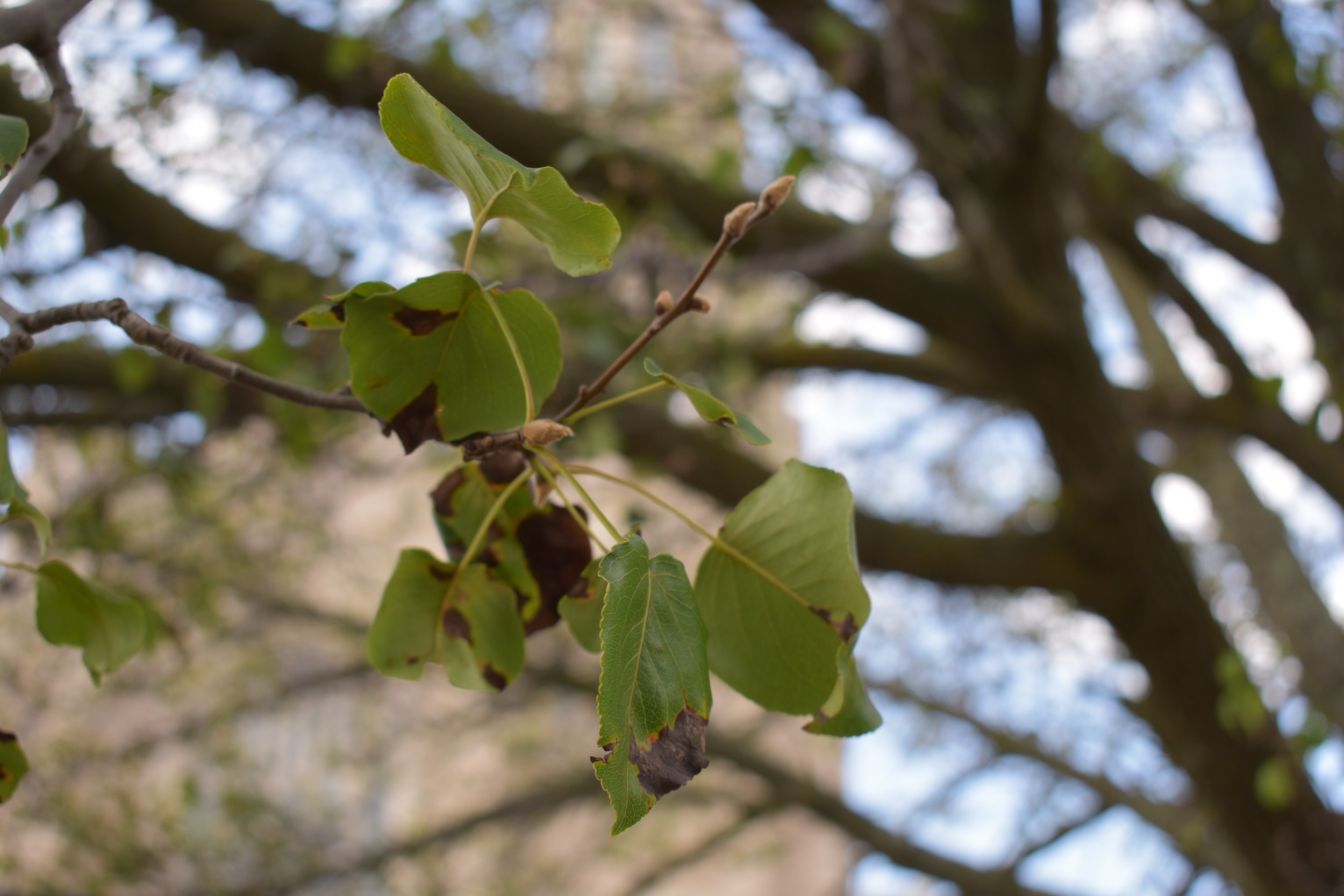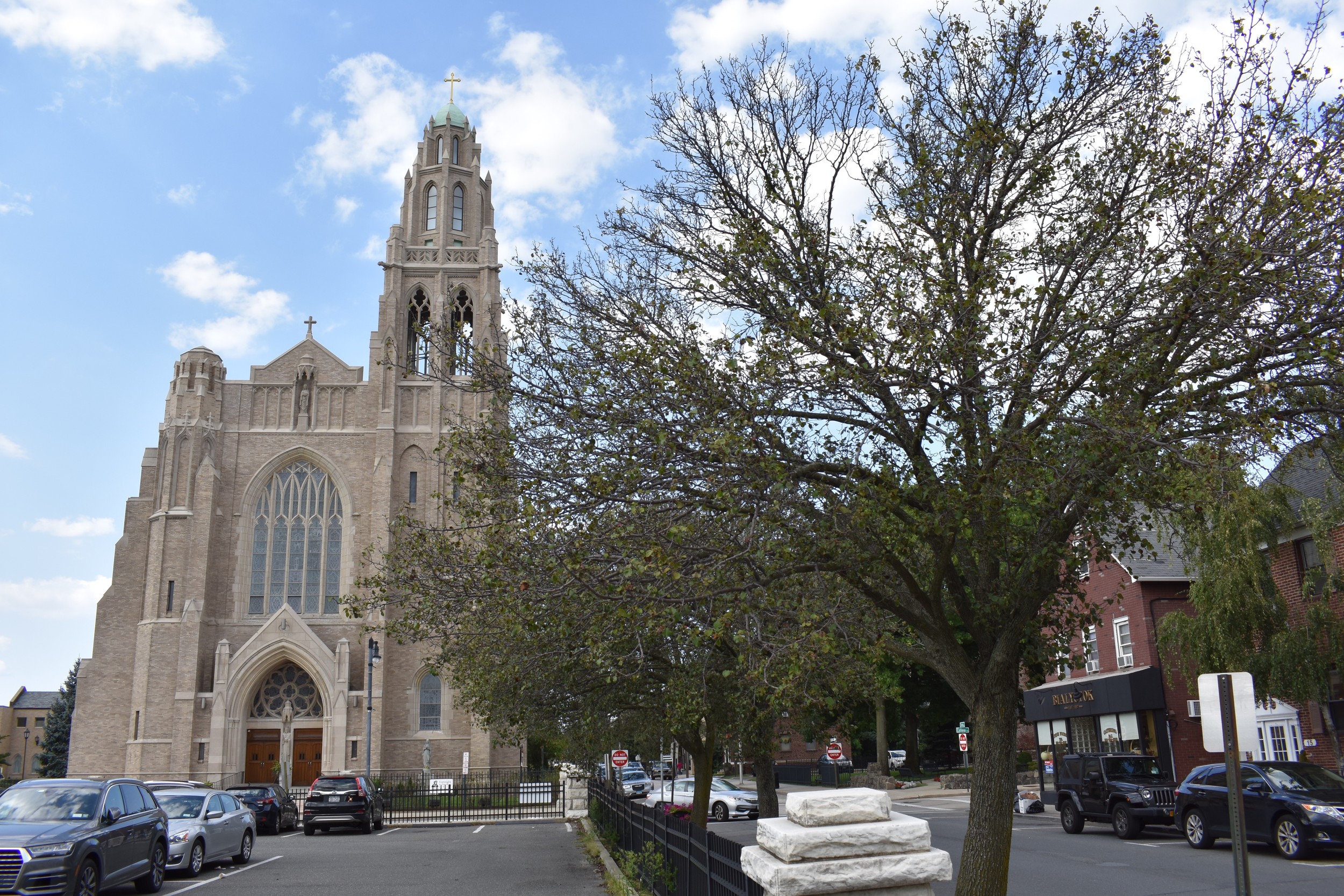Pear trees dying in RVC’s downtown
Rockville Centre’s pear trees are under attack.
The culprit, known as trellis rust — caused by a fungus new to North America — has spread throughout the village, leaving many of the trees partially or fully bare, or with discolored or blotchy leaves.
“It’s pretty evident if you look around town,” said resident Matt Cliszis, a member of the RVC Conservancy, which has launched an initiative to address the issue. “… The leaves are brown or dropping or non-existent. I mean, it’s everywhere.”
Pear trees, used mainly as ornamental trees along streets, have long been popular in the United States because of their beautiful spring blooms. But an estimated 100 trees in the downtown business district are sick, Cliszis said, as well as many others in residents’ yards and curb strips.
Vincent Drzewucki, a subject educator in the horticulture, urban and community forestry department at Cornell University’s Cooperative Extension, said the problem has festered for about a decade, but is worse now. He added that it affects parts of Suffolk County as well as New York City, but is most prevalent in Nassau County’s downtown areas.
Ornamental pear trees are classified as an invasive species in New York, Drzewucki explained, and are not recommended to be planted anymore. In many municipalities, he added, pear trees were the only ones planted.
“Whenever you plant one species everywhere in large numbers, you really run the risk of a pest coming in and wiping them out,” he said. “So because of poor planning and the lack of diversity … in the community, we’ve got sort of a disaster at hand.”
The RVC Conservancy, whose initiatives have focused on beautifying the village, is now looking into arranging a resident-funded mass removal and replanting of the affected residential trees. By working together, Cliszis said, he hopes to secure less expensive removals and replacement trees than homeowners could arrange on their own.
“As residents, we need to be proactive in preserving the look and feel of our community for ourselves and future generations,” Cliszis said. “We cannot sit idly by while these trees that line our streets are dying. Trees help reduce energy costs, create shade, increase property values and bring more business to our commercial district.”
Joe Dee, of Dees’ Nursery & Florist in Oceanside, said the disease, a form of cedar apple rust, will not kill a tree right away, and recommended that homeowners spray fungicide on their trees while they are dormant in the fall, and again in early spring before they bloom. Fire blight, another common disease, starts at twig ends and progresses back toward the main stem.
“If not taken care of, eventually it can weaken the tree enough to kill it,” Dee said, “but if everyone’s worried that their tree’s going to die this first year of having it, it’s not going to happen. They’ll be OK.”
This year, however, Dee admitted the problem, which he said has existed for the last few years, is the worst he has seen. He added that the disease has caused sales of pear trees at his nursery to plummet.
“There’s no such thing as a plant that doesn’t get some sort of insect or disease in its life cycle,” Dee said. “That’s just nature … but there are remedies to correct things.”
But Drzewucki said that spraying pesticides in the downtown areas is not realistic, and added that he had met with the village, which is currently working on a plan.
“Rockville Centre enjoys a vibrant and thriving downtown,” said village spokeswoman Julie Scully. “As one of the most visible indicators of community pride, the village is committed to finding a solution for any dying tree that is lining the business district. The village is currently reviewing all options, as this was not anticipated when the budget was prepared.”
Cliszis said he contacted State Sen. Todd Kaminsky, who called the problem “distressing” in a statement. Kaminsky added that he is consulting with the state’s Department of Environmental Conservation to help the village secure funding to replace dead trees through the Urban and Community Forest Grant.
Drzewucki said it would be expensive to replace the trees with what he recommended to be a variety of species, and that it might require a renovation of the downtown infrastructure and planting areas in order to support healthier trees. He added, however, that he was confident that Rockville Centre, which has been recognized as a Tree City USA by the DEC’s Division of Lands and Forests, will find a solution. After all, he explained, more than beauty is at stake.
“Not replacing them will make the environment unhealthier,” Drzewucki said, “and will drive business to other areas that are more pleasant to shop in.”
Residents who believe their pear trees have been affected by the blight, and are interested in learning about the RVC Conservancy’s plan, can visit www.rvcconservancy.org/tacklingtrees, and complete the form.

 47.0°,
Mostly Cloudy
47.0°,
Mostly Cloudy 







